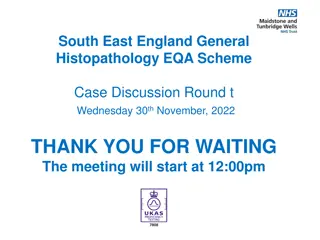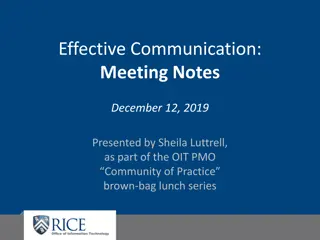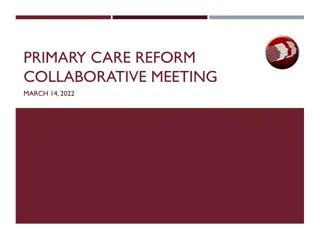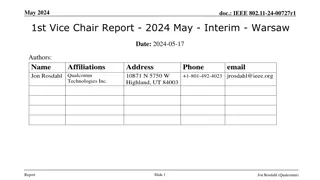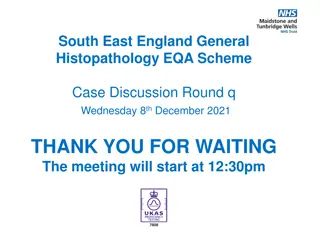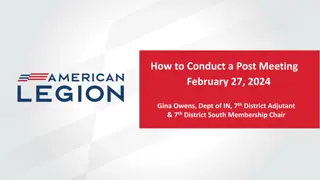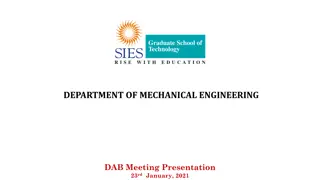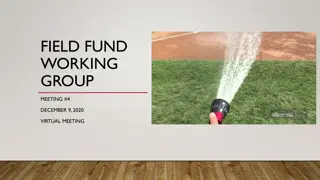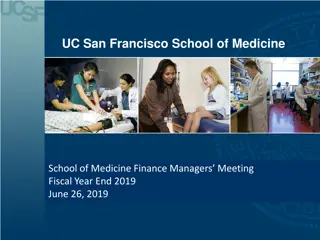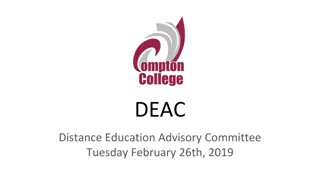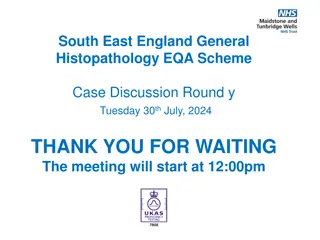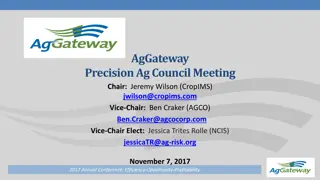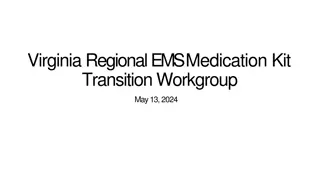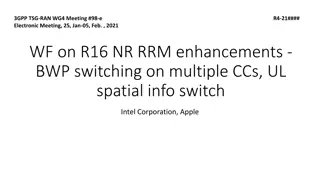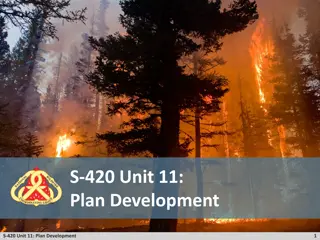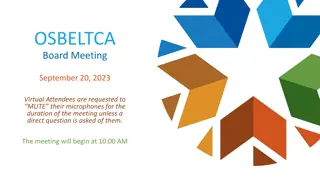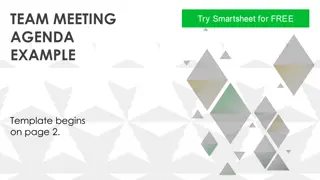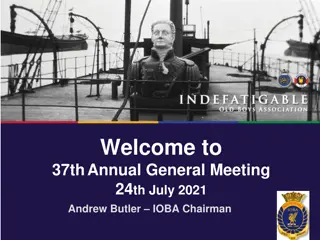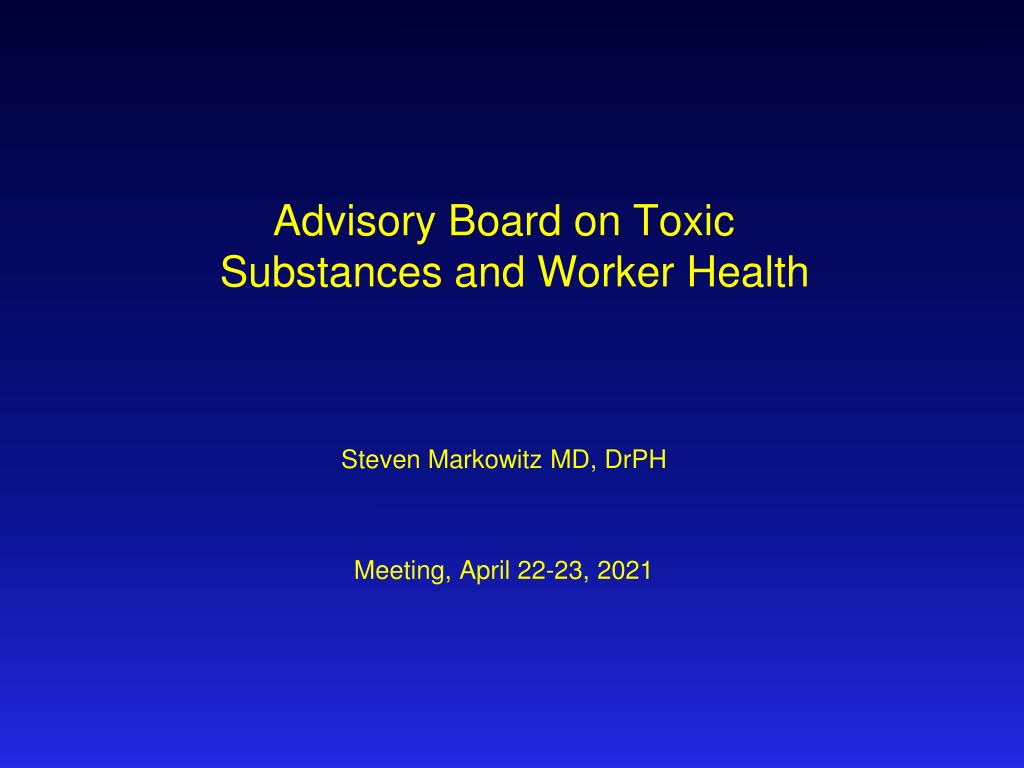
Worker Health Meeting Update: ABTSWH Follow-up Discussions and OHQ Feedback
Stay informed about the latest developments in worker health discussions from the recent ABTSWH meeting, including insights on individual employee performance, case referrals, research considerations, OHQ implementation feedback, and more. Explore key points shared and ongoing initiatives discussed in the session.
Uploaded on | 0 Views
Download Presentation

Please find below an Image/Link to download the presentation.
The content on the website is provided AS IS for your information and personal use only. It may not be sold, licensed, or shared on other websites without obtaining consent from the author. Download presentation by click this link. If you encounter any issues during the download, it is possible that the publisher has removed the file from their server.
E N D
Presentation Transcript
Advisory Board on Toxic Substances and Worker Health Steven Markowitz MD, DrPH Meeting, April 22-23, 2021
Agenda item #4 November 5-6, 2020 ABTSWH Meeting Information Items from
Follow-up Items from November 5-6, 2020 ABTSWH Meeting 1. Ms. Hearthway described an increased focus on individual employee performance through case action sample reviews and the addition of a quality assurance analyst, who will conduct quality reviews on a weekly basis to help guide policy and training management. What is the status of this effort and of any change in the QA work overall? 2. Ms. Pond said that the program refers most cases that have at least some information about exposure and conditions. What proportion and how many cases get referred to IH s on new non-impairment claims? 3. Ms. Pond noted that ideally the program would have a research arm to evaluate claims data, but that all current resources are dedicated to adjudication. Is this an idea that the Department is considering?
Follow-up Items from November 5-6, 2020 ABTSWH Meeting (cont.) 4. EEOICP has begun implementing the new OHQ, and between July and November completed over 612 OHQ interviews with the new format. The Program would ask the Resource Centers for feedback. What is the feedback from the Resource Centers, claims examiners, IH s, and CMC? 5. A public commenter requested that the Board review Dr. Armstrong s directives, communications, and personal opinions within the claims adjudication process and make recommendations to address issues of undue influence. Please clarify the roles of the Medical Director and any medical personnel within EEOICP with regard to review of claims. Are their roles entirely described in the Procedure Manual? If not, what is a written description of their roles? 6. A public commenter noted that the importance of bystander exposure seems to be minimized in claims evaluations. How does the EEOICP deal with claimants potential bystander exposures, especially since they may not be included in the SEM?
OHQ Feedback It is significantly better/more concise/useful than that previous version. It is better organized than the prior version. It s a lot easier to go through compared to the previous format and I think it adequately addresses everything. Like that it s shorter without multiple pages of no information/information we don t use. The old format included a lot of information we never really used. The OHQ's are fine, suggest that they should be an automatic for every new claim from the RC. I do feel it is much more condensed as far as the toxins. I do like it MUCH better than the old format - that was just a lot of wasted pages.
Agenda item #5 Update on Prior Recommendations
Board Recommendation: Sitewide Jobs (Adopted 11/5/20) DOL Response (1/13/21)
Board Recommendation: IH and MD Evaluations (Adopted 11/5/20)
Board Recommendation: IH and MD Evaluations (Adopted 11/5/20) DOL Response (1/13/21)
Board Recommendation: IH and MD Evaluations (Adopted 11/5/20) DOL Response (1/13/21)
Agenda item #7 IARC/NTP Carcinogens
ABTSWH Probable Human Carcinogen Recommendation The Advisory Board on Toxic Substances and Workers Health recommends that toxic substances that are found to be probable human carcinogens (IARC Group 2A) and that have limited human epidemiological evidence for specific human cancer sites as identified in Table 1, should be linked to those cancer sites in the SEM. The SEM should specify that IARC and NTP evaluations have been used in addition to HAZ MAP for the purpose of asserting linkages between toxic substances and human cancer sites. Future IARC Group 2A substance-cancer linkages identified by IARC or NTP should be incorporated in the SEM. Data from IARC and NTP should be used in addition to HAZ MAP for health effects and linkages of toxic substances to cancers.
Agenda item #8 DOL COVID Query
DOL COVID Query DEEOIC is seeking input from the Board regarding whether it is reasonable under certain defined circumstances (as supported by medical health science) to presume that a certain type of accepted work-related illness (e.g. respiratory disorder or particular diagnosed condition) will make the effect of a positive diagnosis of COVID19 worse. Under such a presumptive scenario, DEEOIC would be able to accept that the COVID19 is a compensable consequential illness without further development. Otherwise, DEEOIC would seek out the opinion of a qualified physician to establish such a relationship, as the attached case examples document.
DOL COVID Query Consequential relationship to a previously accepted illness: The effect of an accepted occupational illness under Part B and/or covered illness under Part E in causing, contributing to or aggravating an injury, illness, impairment, or disease is considered a consequential condition. A CE is to accept as compensable any claimed consequential condition(s) that is documented properly by substantive, well-rationalized medical evidence.
Draft COVID Recommendation The Board recommends that any chronic health condition that is listed by the CDC as being associated with severe COVID- 19 disease by meta-analysis, systematic reviews, cohort studies, case control studies, cross sectional studies, case cases/series or mixed evidence be considered to be presumed to lead to symptomatic COVID -19 disease. That is, the diagnosis of symptomatic COVID-19 disease is a consequence of those chronic health conditions when it follows or coincides with the onset of those conditions.
https://www.cdc.gov/coronavirus/2019-ncov/science/science-briefs/underlying-evidence-table.htmlhttps://www.cdc.gov/coronavirus/2019-ncov/science/science-briefs/underlying-evidence-table.html
CDC https://www.cdc.gov/coronavirus/2019-ncov/science/science-briefs/underlying-evidence-table.html
CDC https://www.cdc.gov/coronavirus/2019-ncov/science/science-briefs/underlying-evidence-table.html
CDC https://www.cdc.gov/coronavirus/2019-ncov/science/science-briefs/underlying-evidence-table.html
CDC https://www.cdc.gov/coronavirus/2019-ncov/covid-data/investigations- discovery/hospitalization-death-by-race-ethnicity.html
Agenda item #9 Asbestos Recommendation Working Group Mike Van Dyke, Dianne Whitten, Mark Catlin, Steven Markowitz
ABTSWH Response to PTS Asbestos Report for DOL Draft Additional ABTSWH Recommendation Concerning Asbestos We recommend that Paragon Technical Services (PTS) re- evaluate the job titles of Chemical Engineers, Industrial, Health, & Safety Engineers, and Mechanical Engineers and that these titles be added to the list of occupations presumptively exposed to the asbestos under EEOICP. We request access to the Generic Profiles, including the Asbestos Generic profile, as cited in the PTS report. We recommend that DOL clarify how DOE jobs that correspond to the job title Maintenance and Repair, General Helper are classified within the SEM and whether they are linked to asbestos exposure.
Occupations with Very Elevated Risk of Malignant Mesothelioma (PMR>250) Source: NOMS data submitted to EEOICP by ABTSWH
Paragon Technical Services, Inc. Recommendation to US Department of Labor Office of Workers Compensation Programs Division of Energy Employees Occupational Illness Compensation For Integrating the Recommendation of the Department of Labor Advisory Board on Toxic Substances and Worker Heath Jobs Presumed Asbestos Exposure
ABTSWH Response to PTS Asbestos Report for DOL The PTS report argues against presumptive asbestos exposure for some occupations identified in the National Occupational Mortality Surveillance (NOMS) as having excess mesothelioma risk when: 1) Asbestos does not appear for the occupation in the SEM 2) Job titles in NOMS encompass work in diverse industries that may have limited and uncertain relevance to work at DOE sites 3) Job titles may not have widespread exposure to asbestos across many job settings, or 4) The occupations are infrequent at DOE.
ABTSWH Response to PTS Asbestos Report for DOL These arguments are unpersuasive for occupations in NOMS with: a) High Proportionate Mortality Ratio (PMR > 250) b) A substantial number of mesothelioma cases (> 30 cases) c) Reasonably high frequency within DOE complex
Occupations with Very Elevated Risk of Malignant Mesothelioma (PMR>250) Source: NOMS data submitted to EEOICP by ABTSWH
ABTSWH Response to PTS Asbestos Report for DOL These arguments are unpersuasive for occupations in NOMS with: a) High Proportionate Mortality Ratio (PMR> 250) b) A substantial number of mesothelioma cases (> 30 cases) c) Reasonably high frequency within DOE complex NOMS-identified occupations meeting these criteria include: Chemical Engineers (PMR = 449; # MM deaths = 30) Industrial, Health, & Safety Engineers (PMR = 259; # MM deaths = 30) Mechanical Engineers (PMR = 250; # MM deaths = 50)
ABTSWH Response to PTS Asbestos Report for DOL PTS Report, p. 2 Note: Janitorial activities, Laundry, Power/Communication line maintenance. These are not on EEOICP asbestos presumption list.
ABTSWH Response to PTS Asbestos Report for DOL Draft Additional ABTSWH Recommendation Concerning Asbestos We recommend that Paragon Technical Services (PTS) re- evaluate the job titles of Chemical Engineers, Industrial, Health, & Safety Engineers, and Mechanical Engineers and that these titles be added to the list of occupations presumptively exposed to the asbestos under EEOICP. We request access to the Generic Profiles, including the Asbestos Generic profile, as cited in the PTS report. We recommend that DOL clarify how DOE jobs that correspond to the job title Maintenance and Repair, General Helper are classified within the SEM and whether they are linked to asbestos exposure.
Agenda Item #7 Six Minute Walk Test
6MWT The 6MWT is a field test that is widely available, does not require specialized equipment, and can be performed safely in a typical medical office setting by most patients with pulmonary or cardiac compromise. The ERS/ATS Technical Standard published by Holland et al. (2014) provides standardized instructions and quality assurance procedures for the 6MWT.
Six Minute Walk Test 1. The 6MWT has been well studied for patients with a variety of lung disorders and is reported to have acceptable repeatability, reproducibility, safety and precision to predict mean VO2max of a group (Singh, 2014; Sood, 2014; Ross, 2010; Cahalin, 1995). 2. A systematic review by the European Respiratory Society / American Thoracic Society in 2014 concluded that the 6MWT is a valid, reliable, and robust test of functional exercise capacity in adults with chronic respiratory disease (Singh 2014). 3. The systematic review also concluded that the relationship between 6MWD and either VO2peak or peak work on a progressive incremental Cardiopulmonary Exercise Testing (CPET) was moderate to strong and was consistent across patient groups with chronic obstructive pulmonary disease and interstitial lung disease.
Six Minute Walk Test The 6MWT measures peak VO2 (VO2peak), which provides acceptable estimates of VO2max when VO2max is not clinically advisable or achievable. Both the CPET and the 6MWT would generally yield a VO2peak rather than a VO2max in most or all of these patients since individuals with significant lung disease can rarely achieve the maximal anaerobic level of exertion needed to generate a true VO2max on the CPET.
Six Minute Walk Test The best available method to estimate the VO2peak in an individual patient is to use the equation published by Ross et al in 2010. This equation is: Mean Peak VO2 (ml / kg /min) = 4.948 + 0.023*Mean 6MWD (meters) This regression equation was derived from pooled data taken from 11 studies conducted between 1996 and 2006 including a total of 1,083 patients with diverse cardiopulmonary disorders.
Recommendation: 6MWT The Board advises that the 6MWT is an entirely acceptable to measure the VO2max for the purposes of impairment assessment. The best valid and available method to estimate a value of VO2max from the 6MWD for application in Table 5-12 of the AMA Impairment Guide is to use the equation derived by Ross et al (2010): Mean Peak VO2 (ml / kg /min) = 4.948 + 0.023*Mean 6MWD (meters)
Agenda Item #8 Comments of DOL Impairment Evaluations
Medical Director's Quarterly Audits and CMC Audit Analysis, 2018 & 2019 2018 2019 No. that "need improvement" (%) No. that "need improvement" (%) No. that "need improvement" (%) Type of Review Total No. Total No. Grand Total 67 1 (1%) 0 (0%) Causation Impairment Other* Total 79 71 146 1 (0.68%) 67 25 (37%) 19 (27%) 138 44 (32%) 63 12 (19%) 47 3 (6%) 110 15 (14%) 197 38 (19%) 197 22 (11%) 394 60 (15%) *includes clarification of diagnosis reports, referee & second opinions, and supplemental file reviews There are no Medical Director Quarterly Audit Reports for 2020 posted online
Questions on Impairment Ratings 1. How many Impairment Ratings have been performed in the last two years? 2. How many of those Impairment Ratings have been flagged for review by the Medical Director? 3. How many of the Impairment Ratings that the Medical Director has flagged have been challenged in one way or another? 4. Are there specific Impairment physicians with more challenged Impairment Ratings than other physicians? 5. What actions has the CMC contractor taken to improve impairment ratings?



